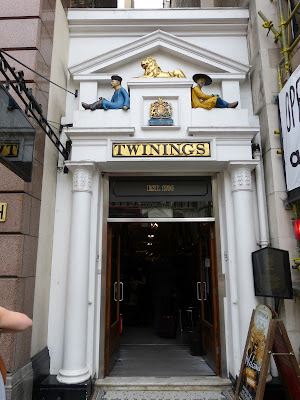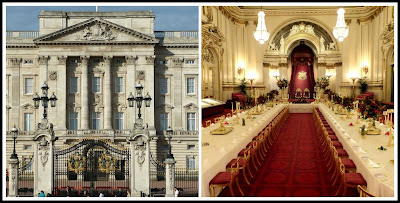 |
A Royal Welcome at Buckingham Palace - the front of Buckingham Palace
and the Ballroom laid out for a state banquet Photos © Andrew Knowles |
This summer’s exhibition (2015) at Buckingham Palace gives visitors a taste of what it is like to be an official guest at the palace. Andrew and I were invited to a bloggers’ breakfast last week to view the exhibition with a guided tour by curator Anna Reynolds. We were extremely privileged to be allowed to take photos in many of the rooms—not something that is normally permitted. Thanks to Andrew, I have lots of pictures to share to help you experience a Royal Welcome. The exhibition closed on 27 September 2015.
The longest reigning British monarch
Her Majesty Queen Elizabeth II was the longest reigning British monarch, overtaking Queen Victoria.
The Grand Entrance
The first difference from our previous visits to Buckingham Palace was the way in. This year, visitors to the palace enter the State Rooms through the Grand Entrance that invited guests use. The Australian state coach is on display outside this entrance so that visitors can imagine they have just arrived in it (if only!).
 |
The Australian state coach outside the Grand Entrance
of Buckingham Palace Photo © Andrew Knowles |
The Grand Staircase
From the Grand Entrance, you pass through the Grand Hall and up the Grand Staircase. On our tour, we went straight to the top and were able to capture the full length of the magnificent staircase. The balustrade is magnificent, made of gilded bronze, and at the top we looked up to see some very familiar faces –
George III and
Queen Charlotte.
 |
The Grand Hall, Buckingham Palace
Photo © Andrew Knowles |
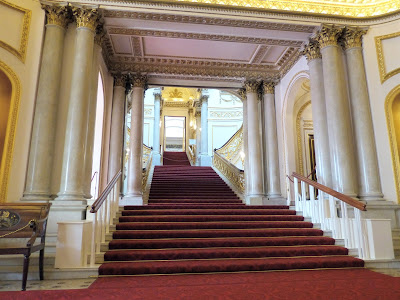 |
View up the Grand Staircase, Buckingham Palace
Photo © Andrew Knowles |
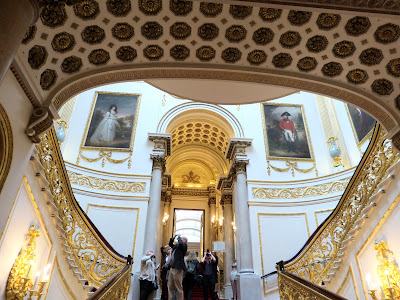 |
The Grand Staircase, Buckingham Palace
Photo © Andrew Knowles |
The Throne Room
In the Throne Room, there were displays on the theme of investitures. There was a video of various people receiving their honours, as well as pictures of some recipients of the Order of Merit including a portrait of Sir Tom Stoppard and a self-portrait by David Hockney. The knighting stool and a sword used for conferring knighthoods were also on display.
 |
Knighting stool
© Royal Collection Trust Queen Elizabeth II 2015 |
 |
Portrait of Sir Tom Stoppard
© Royal Collection Trust Queen Elizabeth II 2015 |
Preparing for a state visit
In the main exhibition area, there were several displays set up which showed how the palace staff prepare for a state visit. These included insights into the office, the kitchen, the wine cellar and the dressmaker’s workshop.
Getting ready in the office
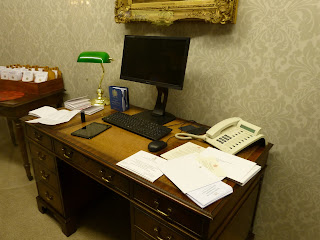 |
Part of the office display in a Royal Welcome
2015 exhibition at Buckingham Palace
Photo © Andrew Knowles |
 |
An invitation to a state banquet in the office display
in a Royal Welcome 2015 exhibition at Buckingham Palace
Photo © Andrew Knowles |
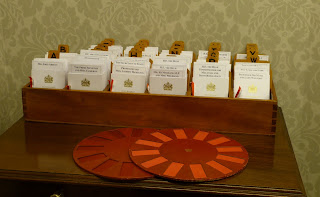 |
Invitations to a state banquet in the office display
in a Royal Welcome 2015 exhibition at Buckingham Palace
Photo © Andrew Knowles |
 |
Programme for a state visit in the office display in
a Royal Welcome 2015 exhibition at Buckingham Palace
Photo © Andrew Knowles |
I particularly liked the little booklets (shown above) that guests are given so that they know the names of everyone else who is attending the state banquet and where they are sitting, a menu and other useful information. The aim is to make the guests feel relaxed, not to catch them out!
Preparing food for a state banquet
 |
The kitchen display in a Royal Welcome 2015 exhibition
at Buckingham Palace - Photo © Andrew Knowles |
 |
Chocolates in the kitchen display in a Royal Welcome
2015 exhibition at Buckingham Palace
Photo © Andrew Knowles |
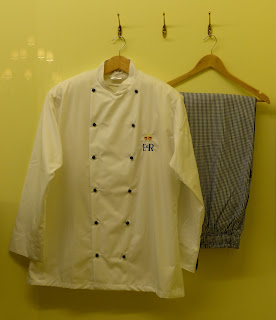 |
Uniform in the kitchen display in a Royal Welcome
2015 exhibition at Buckingham Palace
Photo © Andrew Knowles |
 |
Making chocolate buttons in the mould of uniform
buttons in the kitchen display in a Royal Welcome
2015 exhibition at Buckingham Palace
Photo © Andrew Knowles |
 |
Making chocolate buttons in the mould of uniform buttons in the kitchen
display in a Royal Welcome 2015 exhibition at Buckingham Palace
Photo © Andrew Knowles |
Preparing the wine for a state banquet
 |
The wine cellar display in a Royal Welcome
2015 exhibition at Buckingham Palace
Photo © Andrew Knowles |
 |
The wine cellar display in a Royal Welcome
2015 exhibition at Buckingham Palace
Photo © Andrew Knowles |
Preparing the tableware for a state banquet
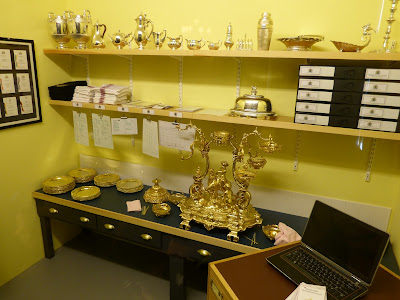 |
Preparing the tableware for a state banquet in a Royal Welcome
2015 exhibition at Buckingham Palace
Photo © Andrew Knowles |
 |
Preparing the tableware for a state banquet in a Royal Welcome
2015 exhibition at Buckingham Palace
Photo © Andrew Knowles |
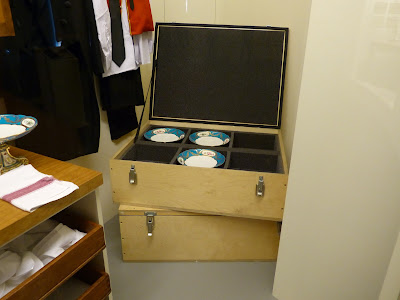 |
Getting out the plates for a state banquet in a Royal Welcome
2015 exhibition at Buckingham Palace
Photo © Andrew Knowles |
 |
Getting out the cutlery for a state banquet in a Royal Welcome
2015 exhibition at Buckingham Palace
Photo © Andrew Knowles |
Preparing clothes fit for the Queen
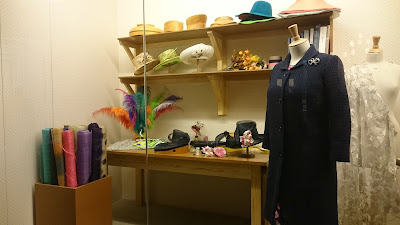 |
The dressers' workroom in a Royal Welcome
2015 exhibition at Buckingham Palace
Photo © Andrew Knowles |
 |
The dressers' workroom in a Royal Welcome
2015 exhibition at Buckingham Palace
Photo © Rachel Knowles |
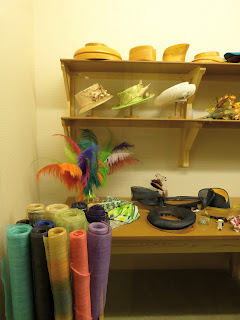 |
The dressers' workroom in a Royal Welcome
2015 exhibition at Buckingham Palace
Photo © Andrew Knowles |
Dressed for a state occasion
I enjoyed the last display, showcasing three of the Queen’s dresses used for state occasions, together with photos of her wearing them. Some of her jewellery was on display, including the coronation necklace, Queen Mary’s Dorset bow brooch and the Kokoshnik tiara.
 |
One of the Queen's state outfits in a Royal
Welcome 2015 exhibition at Buckingham
Palace - Photo © Rachel Knowles |
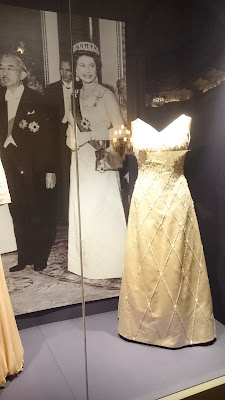 |
One of the Queen's state outfits in a Royal
Welcome 2015 exhibition at Buckingham
Palace - Photo © Rachel Knowles |
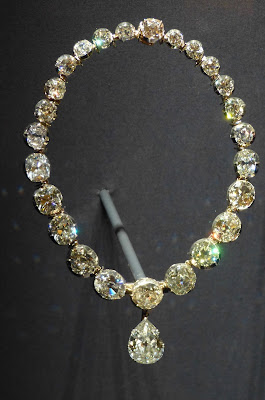 |
The coronation necklace in a Royal Welcome
2015 exhibition at Buckingham Palace
Photo © Andrew Knowles |
 |
The Kokoshnik tiara in a Royal Welcome
2015 exhibition at Buckingham Palace
Photo © Andrew Knowles |
 |
Queen Mary's Dorset bow brooch in a Royal Welcome
2015 exhibition at Buckingham Palace
Photo © Andrew Knowles |
The Ballroom
The Ballroom was set up for a state banquet and I thought the glittering array of tableware was quite dazzling.
 |
The ballroom set up for a state banquet in a Royal Welcome
2015 exhibition at Buckingham Palace
Photo © Andrew Knowles
|
 |
The ballroom set up for a state banquet in a Royal Welcome
2015 exhibition at Buckingham Palace
Photo © Andrew Knowles |
 |
The ballroom set up for a state banquet in a Royal Welcome
2015 exhibition at Buckingham Palace
Photo © Andrew Knowles |
 |
Menu for a state banquet in a Royal Welcome
2015 exhibition at Buckingham Palace
Photo © Andrew Knowles |
 |
Place setting for a state banquet in a Royal Welcome
2015 exhibition at Buckingham Palace
Photo © Andrew Knowles |
There were several videos to watch, my favourite being the one on the middle screen—a speeded up version of them setting up, serving and clearing up after a state banquet. You can watch part of this video here.
State gifts
A selection of gifts given to the Queen on state visits was on display in the State Dining Room, on a table beneath life-size portraits of
George IV and his parents and other royals.
 |
State gifts on display in the State Dining Room in a Royal Welcome
2015 exhibition at Buckingham Palace
Photo © Andrew Knowles |
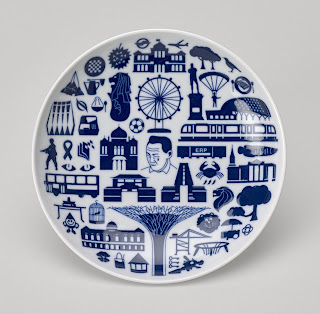 |
Part of a set of porcelain plates given to the Queen
by the President of Singapore in 2014
© Royal Collection Trust Queen Elizabeth II 2015 |
 |
Clay sculpture of a Tree of Life from the President of
Mexico on display in the State Dining Room in a
Royal Welcome 2015 exhibition at Buckingham Palace
Photo © Andrew Knowles |
Music Room
More of the Queen's clothes were on display in the Music Room.
 |
Three of the Queen's state outfits in a Royal
Welcome 2015 exhibition at Buckingham Palace
Photo © Andrew Knowles |
It was a great morning, wandering through the State Rooms and reacquainting myself with all the wonderful portraits of the Georgian royal family. I did not count how many pictures there were of George IV, but there were more of him than of any other monarch! The exhibition brought in several new elements which were a nice variation to what we had seen on previous visits.
Remembering Mrs Jordan
Having blogged about
Mrs Jordan (
William IV's long-standing mistress) recently and how she was ostracised by the royal family during her life, it was reassuring to see her portrait on display alongside the Georgian royals as well as the Chantrey sculpture commissioned by William IV. This was not on display in one of the rooms we visited on our guided tour and so we had no opportunity to photograph it, but Andrew discovered that he had taken a picture of it quite by chance when capturing the view through a doorway from one of the drawing rooms!
 |
Mrs Jordan statue by Chantrey,
on display in Buckingham Palace
Photo © Andrew Knowles |
 |
Mrs Jordan statue by Chantrey,
on display in Buckingham Palace
Photo © Andrew Knowles |
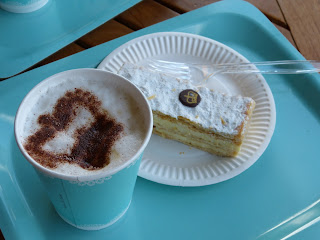 |
| A royal treat in the café © Andrew Knowles |
Rachel Knowles writes faith-based Regency romance and historical non-fiction. She has been sharing her research on this blog since 2011. Rachel lives in the beautiful Georgian seaside town of Weymouth, Dorset, on the south coast of England, with her husband, Andrew.
Find out more about Rachel's books and sign up for her newsletter here.
If you have enjoyed this blog and want to encourage me and help me to keep making my research freely available, please buy me a virtual cup of coffee by clicking the button below.
